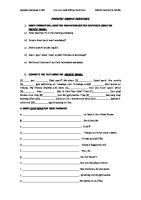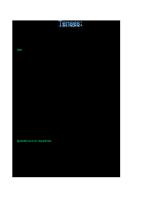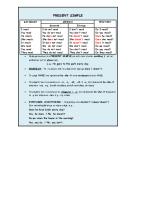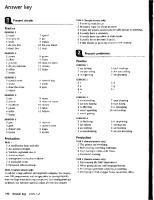Simple Present Tense Abdo [PDF]
SIMPLE PRESENT TENSE THE SIMPLE PRESENT TENSE IS USED: To express habits, general truths, repeated actions or unchan
63 1 166KB
Papiere empfehlen
![Simple Present Tense Abdo [PDF]](https://vdoc.tips/img/200x200/simple-present-tense-abdo.jpg)
- Author / Uploaded
- Abdelhadi Ait Allal
Datei wird geladen, bitte warten...
Zitiervorschau
SIMPLE PRESENT TENSE
THE SIMPLE PRESENT TENSE IS USED:
To express habits, general truths, repeated actions or unchanging situations, emotions and wishes: I smoke (habit); I work in London (unchanging situation); London is a large city (general truth)
To give instructions or directions: You walk for two hundred metres, then you turn left.
To express fixed arrangements, present or future: Your exam starts at 09.00
To express future time, after some conjunctions: after, when, before, as soon as, until: He'll give it to you when you come next Saturday.
Be careful! The simple present is not used to express actions happening now. EXAMPLES
For habits He drinks tea at breakfast. She only eats fish. They watch television regularly.
For repeated actions or events We catch the bus every morning. It rains every afternoon in the hot season. They drive to Monaco every summer.
For general truths Water freezes at zero degrees. The Earth revolves around the Sun. Her mother is Peruvian.
For instructions or directions Open the packet and pour the contents into hot water. You take the No.6 bus to Watney and then the No.10 to Bedford.
For fixed arrangements His mother arrives tomorrow. Our holiday starts on the 26th March
With future constructions She'll see you before she leaves. We'll give it to her when she arrives.
FORMING THE SIMPLE PRESENT TENSE: TO THINK Affirmative
Interrogative
Negative
I think
Do I think?
I do not think
You think
Do you think?
You do not think
He thinks
Does he think?
He does not think
She thinks
Does she think?
She does not think
It thinks
Does it think?
It does not think
We think
Do we think?
We do not think.
They think
Do they think?
They do not think.
NOTES ON THE SIMPLE PRESENT, THIRD PERSON SINGULAR
In the third person singular the verb always ends in -s: he wants, she needs, he gives, she thinks.
Negative and question forms use DOES (= the third person of the auxiliary 'DO') + the infinitive of the verb. He wants ice cream. Does he want strawberry? He does not want vanilla.
Verbs ending in -y : the third person changes the -y to -ies: fly --> flies, cry --> cries Exception: if there is a vowel before the -y: play --> plays, pray --> prays
Add -es to verbs ending in:-ss, -x, -sh, -ch: he passes, she catches, he fixes, it pushes
EXAMPLES
He goes to school every morning.
She understands English.
It mixes the sand and the water.
He tries very hard.
She enjoys playing the piano.
PRESENT CONTINUOUS FORMING THE PRESENT CONTINUOUS The present continuous of any verb is composed of two parts - the present tense of the verb to be + the present participle of the main verb. (The form of the present participle is: base+ing, e.g. talking, playing, moving, smiling) Affirmative Subject
+ to be
+ base + ing
She
is
talking.
Subject
+ to be + not
+ base + ing
She
is not (isn't)
talking
to be
+ subject
+ base + ing
Is
she
talking?
Negative
Interrogative
EXAMPLES: TO GO, PRESENT CONTINUOUS
Affirmative
Negative
Interrogative
I am going
I am not going
Am I going?
You are going
You aren't going.
Are you going?
He, she, it is going
He, she, it isn't going
Is he, she, it going?
We are going
We aren't going
Are we going?
You are going
You aren't going
Are you going?
They are going
They aren't going
Are they going?
Note: alternative negative contractions: I'm not going, you're not going, he's not going etc. FUNCTIONS OF THE PRESENT CONTINUOUS As with all tenses in English, the speaker's attitude is as important as the time of the action or event. When someone uses the present continuous, they are thinking about something that is unfinished or incomplete THE PRESENT CONTINUOUS IS USED:
to describe an action that is going on at this moment: You are using the Internet. You are studying English grammar.
to describe an action that is going on during this period of time or a trend: Are you still working for the same company? More and more peopleare becoming vegetarian.
to describe an action or event in the future, which has already been planned or prepared: We're going on holiday tomorrow. I'm meeting my boyfriend tonight. Are they visiting you next winter?
to describe a temporary event or situation: He usually plays the drums, but he's playing bass guitar tonight. The weather forecast was good, butit's raining at the moment.
with "always, forever, constantly", to describe and emphasise a continuing series of repeated actions: Harry and Sally are always arguing!You're constantly complaining about your mother-in-law!
BE CAREFUL! Some verbs are not usually used in the continuous form VERBS THAT ARE NOT USUALLY USED IN THE CONTINUOUS FORM The verbs in the list below are normally used in the simple form because they refer to states, rather than actions or processes.
SENSES / PERCEPTION
to feel*
to hear
to see*
to smell
to taste
OPINION
to assume
to believe
to consider
to doubt
to feel (= to think)
to find (= to consider)
to suppose
to think*
MENTAL STATES
to forget
to imagine
to know
to mean
to notice
to recognise
to remember
to understand
EMOTIONS / DESIRES
to envy
to fear
to dislike
to hate
to hope
to like
to love
to mind
to prefer
to regret
to want
to wish
MEASUREMENT
to contain
to cost
to hold
to measure
to weigh
OTHERS
to look (=resemble)
to seem
to be (in most cases)
to have(when it means "to possess")*
EXCEPTIONS Perception verbs (see, hear, feel, taste, smell) are often used with can: : I can see... These verbs may be used in the continuous form but with a different meaning
This coat feels nice and warm. (your perception of the coat's qualities)
John's feeling much better now (his health is improving)
She has three dogs and a cat. (possession)
She's having supper. (She's eating)
I can see Anthony in the garden (perception)
I'm seeing Anthony later (We are planning to meet)









